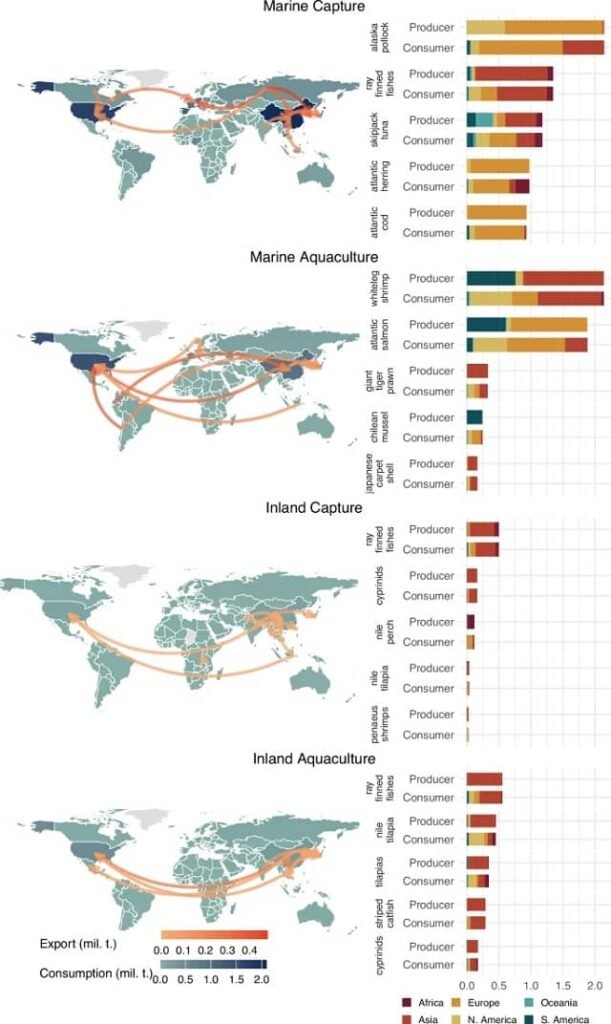
The world of aquatic foods is vast and vital, playing a key role in global food security and nutrition. But did you know that despite its immense scale, crucial details about how we trade and consume these resources largely remain hidden?
A recent groundbreaking study published in Nature Communications by researchers from the University of Washington, American University, University of Michigan, Stanford University, University of Tasmania, The Royal Swedish Academy of Sciences, and Stockholm University is changing that. The researchers have developed a revolutionary database, the first of its kind, that sheds light on the intricate web of global aquatic food trade. This comprehensive resource allows scientists to track trade flows of different species, whether farmed or wild-caught, over an astonishing 25-year period (1996-2020).
The Challenges of Understanding Aquatic Food Trade
Despite the importance of global aquatic food trade, our understanding has been limited due to a lack of detailed data. Traditional trade data often lack information on species, origin, and production methods, making it difficult to assess the full range of benefits and risks associated with the trade.
The Role of Trade: Benefits and Risks
International aquatic food trade plays a crucial role in shaping global food systems. It offers a variety of benefits, including greater food diversity, lower prices, economic growth, and reduced environmental impacts when production occurs in more suitable regions. However, trade can also pose risks, such as promoting unhealthy diets, undermining domestic production, and exacerbating environmental degradation.
The ARTIS Database: A Breakthrough
To address these challenges, researchers have developed the Aquatic Resource Trade in Species (ARTIS) database. This comprehensive database provides detailed information on trade flows of over 2,400 marine and freshwater species from 1996 to 2020. It includes data on production, trade, and consumption, enabling a more nuanced understanding of global aquatic food trade.
Trade on the Rise
For decades, aquatic food trade has been a major player in global food security. The research reveals the true scale of this industry. Did you know that in 2020 alone, nearly 60 million tons of aquatic foods were exported?
However, despite its enormous size, there was a surprising lack of detailed information. Key aspects such as species breakdown, the origin of the catch/farm, and whether the source was wild-caught or farmed remained largely unknown. This lack of data led to a blurry picture of global aquatic food consumption patterns.
The new research presents a groundbreaking database: a comprehensive record of aquatic food trade that spans species, production, conversion factors, and trade data. This allows researchers to calculate the “apparent consumption” of all types of aquatic foods, both farmed and wild-caught, from 1996 to 2020.
Stay Always Informed
Join our communities to instantly receive the most important news, reports, and analysis from the aquaculture industry.
The findings are fascinating:
- Increasing Globalization: The research presents a clear picture of increasing globalization in aquatic food trade. The proportion of production that is exported grew by an astounding 40% over the period analyzed.
- Shifting Trends: Importantly, trends differ between wild-caught and farmed aquatic foods. While consumption of wild-caught marine fisheries declined, overall global aquatic food consumption increased by a significant 19.4%. This suggests a growing reliance on aquaculture to meet global demand.
- Regional Dependency: The research also highlights the rise of some regions heavily dependent on imported aquatic foods. This trend underscores the interconnectedness of the global food system and the need for sustainable practices across the board.
Implications for Food Security, Sustainability, and Resilience
The ARTIS database provides valuable insights into the implications of aquatic food trade for food security, sustainability, and resilience. By understanding the benefits and risks associated with trade, policymakers and stakeholders can make informed decisions to promote sustainable and equitable aquatic food systems.
Conclusion
The ARTIS database represents a significant advancement in our understanding of global aquatic food trade. By providing detailed data on trade flows at the species level, it allows researchers and policymakers to assess the impacts of trade on food security, sustainability, and resilience. As the world continues to grapple with the challenges of food production and consumption, the information provided by the ARTIS database will be invaluable in guiding efforts to build more sustainable and equitable aquatic food systems.
This pioneering research, along with its underlying database, offers a powerful tool for understanding the rapidly evolving aquatic food trade. By enabling a more nuanced analysis of trade patterns and consumption trends, researchers can identify opportunities for sustainable diets that prioritize both nutrition and environmental responsibility.
Contact
Jessica A. Gephart
School of Aquatic and Fishery Sciences, University of Washington
Seattle, WA, USA
Email: gephart@uw.edu
Reference (open access)
Gephart, J. A., Agrawal Bejarano, R., Gorospe, K., Godwin, A., Golden, C. D., Naylor, R. L., Nash, K. L., Pace, M. L., & Troell, M. (2024). Globalization of wild capture and farmed aquatic foods. Nature Communications, 15(1), 1-13. https://doi.org/10.1038/s41467-024-51965-8
Editor at the digital magazine AquaHoy. He holds a degree in Aquaculture Biology from the National University of Santa (UNS) and a Master’s degree in Science and Innovation Management from the Polytechnic University of Valencia, with postgraduate diplomas in Business Innovation and Innovation Management. He possesses extensive experience in the aquaculture and fisheries sector, having led the Fisheries Innovation Unit of the National Program for Innovation in Fisheries and Aquaculture (PNIPA). He has served as a senior consultant in technology watch, an innovation project formulator and advisor, and a lecturer at UNS. He is a member of the Peruvian College of Biologists and was recognized by the World Aquaculture Society (WAS) in 2016 for his contribution to aquaculture.




